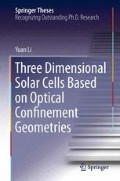Abstract
The fiber-based solar cell is an example of a three dimensional photovoltaic architecture that uses the natural mode structure of optical fibers to enhance light capture (Reprinted from [1], Copyright (2011), with permission from Elsevier). In this work we explore the spectral response of such cells when the thickness of the absorbing layer is varied. We demonstrate two important consequences associated with this architecture. The first is that fiber-based devices generally require a thinner active layer than the analogous planar structure. This helps to avoid exciton recombination and reflection loss in the geometry. Secondly, the geometry exhibits a broader absorption and external quantum efficiency than its planar counterpart. We interpret this as being due to enhanced absorption of charge transfer excitons.
Access this chapter
Tax calculation will be finalised at checkout
Purchases are for personal use only
References
Y. Li, H. Huang, M. Wang, W. Nie, W. Huang, G. Fang, D.L. Carroll, Spectral response of fiber-based organic photovoltaics. Sol. Energ. Mat. Sol. C. 98, (2011). doi:10.1016/j.solmat.2011.10.033
Y. Li, M. Wang, H. Huang, W. Nie, Q. Li, E.D. Peterson, R. Coffin, G. Fang, D.L. Carroll, Influence on open-circuit voltage by optical heterogeneity in three-dimensional organic photovoltaics. Phys. Rev. B. 84, 085206 (2011)
Y. Li, E.D. Peterson, H. Huang, M. Wang, D. Xue, W. Nie, W. Zhou, D.L. Carroll, Tube-based geometries for organic photovoltaics. Appl. Phys. Lett. 96, 243505 (2010)
H. Huang, Y. Li, M. Wang, W. Nie, W. Zhou, E.D. Peterson, J. Liu, G. Fang, D.L. Carroll, Photovoltaic-thermal solar energy collectors based on optical tubes. Sol. Energy 85, 450–454 (2011)
Y. Li, W. Nie, J. Liu, A. Partridge, D.L. Carroll, The optics of organic photovoltaics: Fiber- based devices. IEEE J. Sel. Top. Quant. Electron. 16, 1827–1837 (2010)
B. O’Connor, K.P. Pipe, M. Shtein, Fiber based organic photovoltaic devices. Appl. Phys. Lett. 92, 193306 (2008)
Y. Li, W. Zhou, D. Xue, J. Liu, E.D. Peterson, W. Nie, D.L. Carroll, Origins of performance in fiber-based organic photovoltaics. Appl. Phys. Lett. 95, 203503 (2009)
S. Curran, J. Talla, S. Dias, J. Dewald, Microconcentrator photovoltaic cell (the m-C cell): Modeling the optimum method of capturing light in an organic fiber based photovoltaic cell. J. Appl. Phys. 104, 064305 (2008)
D.W. Sievers, V. Shrotriya, Y. Yang, Modeling optical effects and thickness dependent current in polymer bulk-heterojunction solar cells. J. Appl. Phys. 100, 114509 (2006)
L.A.A. Pettersson, L.S. Roman, O. Inganas, Modeling photocurrent action spectra of photovoltaic devices based on organic thin films. J. Appl. Phys. 86, 487–496 (1999)
R. Hausermann, E. Knapp, M. Moos, N.A. Reinke, T. Flatz, B. Ruhstaller, Coupled optoelectronic simulation of organic bulk-heterojunction solar cells: Parameter extraction and sensitivity analysis. J. Appl. Phys. 106, 104507 (2009)
Open Photovoltaics Analysis Platform (OPVAP) by Yuan Li, USA. www.OPVAP.com
H. Hoppe, N.S. Sariciftci, D. Meissner, Optical constants of conjugated polymer/fullerene based bulk-heterojunction organic solar cells. Mol. Cryst. Liq. Cryst. 385, 233–239 (2002)
F. Monestier, J.J. Simon, P. Torchio, L. Escoubas, F. Florya, S. Bailly, R. de Bettignies, S. Guillerez, C. Defranoux, Modeling the short-circuit current density of polymer solar cells based on P3HT: PCBM blend. Sol. Energ. Mat. Sol. C. 91, 405–410 (2007)
Refractive Index. Info. database http://refractiveindex.info
M. Caglar, S. Ilican, Y. Caglar, F. Yakuphanoglu, The effects of Al doping on the optical constants of ZnO thin films prepared by spray pyrolysis method. J. Mater. Sci-Mater. El. 19, 704–708 (2008)
A. Pivrikas, G. Juscaronka, A.J. Mozer, M. Scharber, K. Arlauskas, N.S. Sariciftci, H. Stubb, R.O. Sterbacka, Bimolecular recombination coefficient as a sensitive testing parameter for low-mobility solar-cell materials. Phys. Rev. Lett. 94, 176806 (2005)
F. Yang, M. Shtein, S.R. Forrest, Controlled growth of a molecular bulk heterojunction photovoltaic cell. Nat. Mater. 4, 37–41 (2005)
G. Juska, K. Arlauskas, J. Stuchlik, R. Österbacka, Non-Langevin bimolecular recombination in low-mobility materials. J. Non-Cryst. Solids 352, 1167–1171 (2006)
ASTM Standard G173, 2003e1, Standard Tables for Reference Solar Spectral Irradiances: Direct Normal and Hemispherical on 37° Tilted Surface (ASTM International, West Conshohocken, PA, 2003). doi: 10.1520/G0173-03E01, www.astm.org
X.J. Wang, E. Perzon, J.L. Delgado, P. de la Cruz, F.L. Zhang, F. Langa, M. Andersson, O. Inganas, Infrared photocurrent spectral response from plastic solar cell with low-band-gap polyfluorene and fullerene derivative. Appl. Phys. Lett. 85, 5081–5083 (2004)
X.Y. Zhu, Q. Yang, M. Muntwiler, Charge-transfer excitons at organic semiconductor surfaces and interfaces. Accounts. Chem. Res. 42, 1779–1787 (2009)
Y. Chia-Ming, T. Pei-Yu, H. Sheng-Fu, L. Kuan-Chen, T. Shin-Rong, M. Hsin-Fei, S. Jow-Tsong, S. Ching-Fong, Infrared photocurrent response of charge-transfer exciton in polymer bulk heterojunction. Appl. Phys. Lett. 92, 083504 (2008)
R.A. Marsh, J.M. Hodgkiss, S. Albert-Seifried, R.H. Friend, Effect of annealing on P3HT:PCBM charge transfer and nanoscale morphology probed by ultrafast spectroscopy. Nano Lett. 10, 923–930 (2010)
I.W. Hwang, D. Moses, A.J. Heeger, Photoinduced carrier generation in P3HT/PCBM bulk heterojunction materials. J. Phys. Chem. C 112, 4350–4354 (2008)
Author information
Authors and Affiliations
Corresponding author
Rights and permissions
Copyright information
© 2013 Springer Science+Business Media New York
About this chapter
Cite this chapter
Li, Y. (2013). Spectral Response. In: Three Dimensional Solar Cells Based on Optical Confinement Geometries. Springer Theses. Springer, New York, NY. https://doi.org/10.1007/978-1-4614-5699-5_4
Download citation
DOI: https://doi.org/10.1007/978-1-4614-5699-5_4
Published:
Publisher Name: Springer, New York, NY
Print ISBN: 978-1-4614-5698-8
Online ISBN: 978-1-4614-5699-5
eBook Packages: Physics and AstronomyPhysics and Astronomy (R0)

